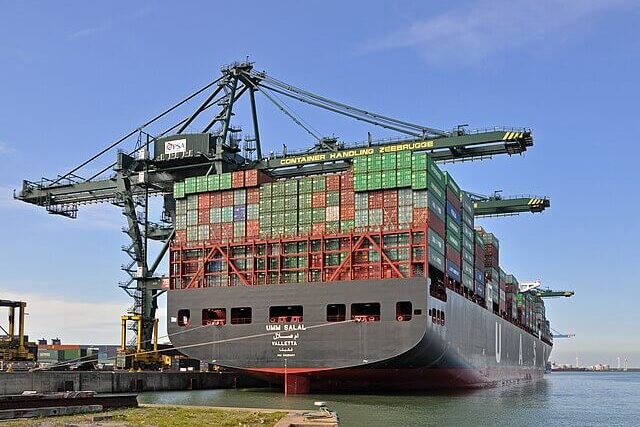
The global shipping industry has reached an accord to achieve net-zero emissions of planet-warming gases “by or around 2050.”
While this pact holds potential for mitigating climate impact, critics assert that the agreement’s shortcomings could undermine its efficacy.
Shipping activities currently contribute approximately 3% of global carbon dioxide (CO2) emissions. The new agreement necessitates nations to significantly curtail these emissions, aiming to approach zero by the mid-century mark. While smaller island nations have greeted this plan with enthusiasm, environmental advocacy groups remain vehemently dissatisfied, deeming the strategy insufficient to effectively combat escalating global temperatures.
The international shipping sector is a linchpin of global trade, facilitating the movement of up to 90% of commercial goods. However, this vital trade network is accompanied by substantial environmental costs, as ships predominantly employ carbon-intensive fuels to power their engines. The emissions from these maritime engines are equivalent to the annual carbon output of Germany.
The intricacies of ship ownership, often spanning multiple countries for registration and operation, have rendered the maritime industry challenging to regulate. This complexity led to shipping being omitted from the landmark Paris Agreement in 2015, which sought a unified global approach to addressing climate change.
In 2018, the shipping industry committed to halving its carbon emissions by 2050, a pledge deemed insufficient by the scientific community. The pressure to enact more substantial change, bolstered by a coalition of nations including the UK, the US, and Pacific island states, has now culminated in a revised strategy. This newly adopted plan aims to achieve net-zero emissions “by or around” 2050, a concept wherein any residual emissions would be offset by active removal of greenhouse gases from the atmosphere.
While wealthier nations and smaller island states championed a 50% emissions reduction by 2030 and a 96% decrease by 2040, resistance from countries such as China, Brazil, and Saudi Arabia has led to the establishment of “indicative checkpoints” instead of stringent targets. These interim goals aspire to reduce shipping emissions by at least 20% by 2030 and at least 70% by 2040. The agreement encourages nations to strive for more ambitious benchmarks of 30% by 2030 and 80% by 2040.
“This outcome is far from perfect, but countries across the world came together and got it done – and it gives us a shot at 1.5C,” said Ralph Regenvanu, Vanuatu’s climate change minister.
This accord is of utmost significance to the broader context of the Paris Agreement, which underscores the imperative of limiting global temperature rise to 1.5°C. Industry stakeholders have expressed mixed reactions to the new agreement, highlighting the potential benefits while also voicing reservations.
“It’s a remarkable improvement that the revised strategy now aims to achieve net-zero emissions by or around 2050, and the introduction of indicative 2030 and 2040 checkpoints for emissions reductions sends an important signal to governments and industry,” said Johannah Christensen, chief executive of the Global Maritime Forum.
“However, the revised strategy falls short to provide the necessary clarity and strong commitments for a just and equitable Paris Agreement-aligned transition.”
Critics within the environmental sphere assert that the agreement’s current framework inadequately addresses the urgent need to remain within the 1.5°C temperature increase threshold.
“While the inclusion of 2030 and 2040 emissions reduction targets for shipping is not insignificant, this strategy will see the shipping industry exhaust its 1.5C carbon budget by 2032,” said Madeline Rose, from the Pacific Environment campaign group.
However, the accord does retain the prospect of a carbon levy on shipping, a concept fervently supported by developing nations. This levy is anticipated to play a pivotal role in curbing emissions over the course of subsequent decades.
“Ultimately it’s not the targets but the incentives we put in place to meet them. So we in the Pacific are going to keep up a strong fight for a levy that gets us to zero emissions by 2050,” said Minister Regenvanu.
——————————————————————————
At Natural World Fund, we are passionate about stopping the decline in our wildlife.
The decline in our wildlife is shocking and frightening. Without much more support, many of the animals we know and love will continue in their decline towards extinction.
When you help to restore a patch of degraded land through rewilding to forests, meadows, or wetlands, you have a massive impact on the biodiversity at a local level. You give animals a home and food that they otherwise would not have had, and it has a positive snowball effect on the food chain.
We are convinced that this is much better for the UK than growing lots of fast-growing coniferous trees, solely to remove carbon, that don’t actually help our animals to thrive.
This is why we stand for restoring nature in the UK through responsible rewilding. For us, it is the right thing to do. Let’s do what’s right for nature!
Donate today at https://naturalworldfund.com/ and join in the solution!

